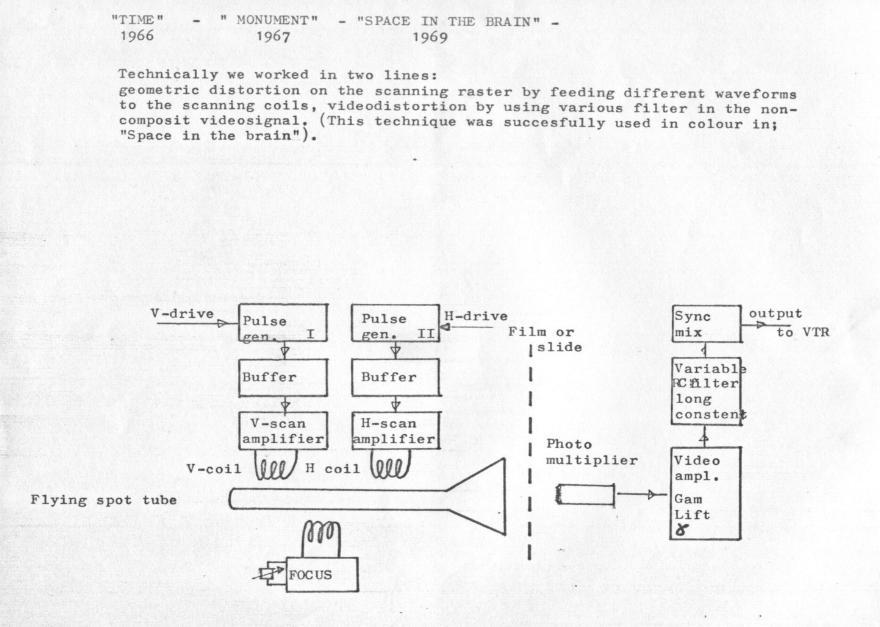| Publication Type | Miscellaneous |
| Source | (undated) |
| Keywords | tools |
Professor Dr. Bjorn Hallstrom, TIME, 1976
In the short history of video animation the Swedish artists TURE SJOLANDER and BROR WIKSTROM are the pioneers. Their television art programme TIME (1965 - 1966) seems to be the first distortion of video-scan-line rasters achieved by applying tones from wave form generators.
TIME, 1966-69
Letter from: RUTT ELECTROPHYSICS, March 12, 1974
Block Diagram
"VIDEOART" ELECTRONIC PAINTINGS - TELEVISED 1966 - 1967 - 1969.
1965."The role of Photography" Commissioned by the National Swedish Television year 1964. B/w. Multimedia/electronic experiment. 30 minutes.
1966."TIME" - b/w, Commissioned by the National Swedish Television. Electronic paintings televised in September 1996. 30 minutes. A video synthesizer was temporarily built, in spite of the TV-technicians apprehension. (Same technical system was later used to create MONUMENT one year later, 1967.) See letters from RUTT ELECTROPHYSICS, NY, USA dated March 12, 1974, below *. In principle this process is similar to methods used by Nam June Paik and others, same years later. Rutt&Etra . Nam June Paik visited Elektronmusic Studion in Stockholm July/August 1966 , during the Festival; "Visions of Now". Static pictures from TIME was demonstrated for Paik at this point in time. Parts of "TIME" was planned to be send via satellite to New York, but the American participants, pulled out. "TIME" is the very first 'videoart'-work televised as an ultimate exhibition/installation statement, televised at that point in 'time' for the reason to produce an historical record as well as an evidence of 'original' visual free art, made with the electronic medium - manipulation of the electronic signal - and 'exhibited/installed through the televison, televised. The work was commenced early 1966. Painting on canvass and paper was made from the static material, in silk-screen prints, for a large numbers of Fine Arts Galleries and Museums 1966, ironically in a 'limited edition', signed and numbered.
1967."MONUMENT" - b/w. Electronic paintings televised in 5 European Nations; France, Italy, Sweden, Germany and Switzerland, 1968. Monument reached an audience of more than 150 million. The work surpassed the limits of "videoart" - a word first used in the beginning of 1970 - 73 - and was developed into an extended communication project, multimedia artwork including creation of tapestries, silk/screen prints, poster, LP/Record Music, paintings on canvass, and a book among other thing, exhibited in several international Fine Arts Galleries.
1968.See text on site from; Gene Youngbloods book "Expanded Cinema". 1970.
1969."SPACE IN THE BRAIN" - 30 minutes. First colour electronic original painting where the electronic signal where manipulated. Described in media as a Space Opera. Based on authentic material delivered from NASA. Space in the Brain was a creation dealing with the space out there - the space in our brains and the electronic space. (in television) Contemporary to Clarke's 2001, except that the Picture it self was scrutinized and focused, in Space in the Brain. The Static material from the electronic paintings was worked out into other medias and materials, as in "TIME" and "MONUMENT", see above.
Letter from: RUTT ELECTROPHYSICS, March 12, 1974
Signed by Sherman Price.
To: International Section of Swedish National Television, Stockholm, Sweden.
Extracts:
I am writing a detailed magazine article about the history of video animation.
From literature avaiable I gather that a videofilm program, "MONUMENT", broadcast in Stockholm in January,1968, was the first distortion of video scan-line rasters achieved by applying tones from wave form generators.
This is of such great importance - historically - that I would like to obtain more detailed documentation of the program and of the electronic circuitry employed to manipulate the video images.
I understand from your New York office that there may have been a brochure or booklet published about the program.
I will be happy to pay any expense for publications, photcopies or other documents about the program and its production -particulary with regard to the method of modulating the deflection voltage in the flying-spot telecine used.
Video synthesis is becoming a prominent technique in TV production here in the United States, and I think it will be interesting to give credit to your broadcasting system and personal for achieving this historic innovation.
